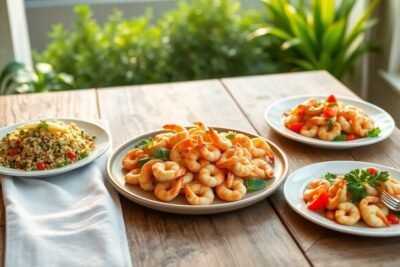
Delicious Diabetic-Friendly Tuna Recipes You Must Try
- Introduction to Diabetic-Friendly Eating
- Why Choose Tuna for Diabetics?
- Essential Ingredients for Diabetic-Friendly Tuna Recipes
- Zucchini Noodle Tuna Salad
- Tuna-Stuffed Bell Peppers
- Recipe 3: Mediterranean Tuna Quinoa Bowl
- Tips for Cooking and Storing Tuna
- Incorporating More Fish into Your Diet
- Engaging with Our Community
- Conclusion: Eating Well with Diabetes
Introduction to Diabetic-Friendly Eating
Adopting a diabetic-friendly diet is essential for managing diabetes and promoting overall health. This approach to eating plays a critical role in stabilizing blood sugar levels, reducing the risk of complications, and improving quality of life. The food we consume significantly affects our blood glucose levels, underlining the importance of making informed food choices. Individuals with diabetes should aim to incorporate a variety of nutrient-rich foods while avoiding excessive sugars and refined carbohydrates.
Fluctuations in blood sugar can lead to a range of health issues, including fatigue, mood swings, and more severe complications over time. Therefore, a balanced diet should include a healthy mix of proteins, fibers, fruits, vegetables, and whole grains. A nutrient-dense meal plan not only supports blood glucose regulation but can also enhance satiety and overall wellbeing. Moreover, individuals with diabetes often benefit from meals that use lower glycemic index foods, which help to maintain more stable glucose levels after eating.
One versatile option that fits well into a diabetic-friendly diet is tuna. Rich in protein and omega-3 fatty acids, tuna offers numerous health advantages, making it an excellent choice for individuals looking for satisfying yet healthy meal options. Implementing delicious, diabetic-friendly tuna recipes can lead to creative possibilities in meal preparation while adhering to dietary needs. Not only do these recipes satisfy the palate, but they also demonstrate that diabetes-friendly meals can be enjoyable and varied. This blog will present a selection of scrumptious tuna recipes designed specifically for those managing diabetes, ensuring that healthy eating remains both enjoyable and fulfilling.
Why Choose Tuna for Diabetics?
Tuna is often hailed as a top choice for those looking to maintain a healthy diet, especially for individuals managing diabetes. One of the primary reasons for this recommendation is its remarkably low carbohydrate content, making it a suitable option for diabetic-friendly meal plans. Managing carbohydrate intake is crucial for diabetics, as it directly impacts blood sugar levels. Since tuna contains minimal carbs, it helps individuals with diabetes avoid spikes in their glucose readings.
In addition to its low carbohydrate levels, tuna is an excellent source of high-quality protein. Protein is an essential nutrient that aids in maintaining muscle mass and supports the body's overall functioning. For diabetics, consuming adequate protein can enhance satiety, potentially leading to better weight management—a key aspect of diabetes control. Incorporating protein-rich foods like tuna into meals can help maintain balanced blood sugar levels by providing the body with steady energy without excessive carbohydrate intake.
Moreover, tuna is packed with heart-healthy omega-3 fatty acids, particularly EPA and DHA. These fatty acids are crucial for cardiovascular health, which is particularly important for diabetics, as they are at a higher risk of developing heart-related issues. Omega-3s help reduce inflammation, support healthy cholesterol levels, and improve overall heart function. Including diabetic friendly tuna recipes in your diet can contribute to better heart health while simultaneously aiding in the management of diabetes.
Incorporating tuna into your meals can thus play a significant role in a balanced diabetic diet. Its rich nutritional profile, including low carbohydrates and high protein content alongside healthy fats, positions tuna as a beneficial food choice for those navigating the complexities of managing diabetes while striving for delicious and satisfying meals.
Essential Ingredients for Diabetic-Friendly Tuna Recipes
Creating diabetic-friendly tuna recipes involves selecting ingredients that are not only flavorful but also beneficial for maintaining optimal blood sugar levels. The key to these recipes lies in assembling fresh vegetables, whole grains, and healthy fats, which work synergistically with the protein-rich tuna to enhance nutritional value without elevating glycemic responses.
Start with fresh vegetables, which serve as the cornerstone of any healthy dish. Vegetables such as spinach, bell peppers, cucumbers, and zucchini are excellent options due to their low caloric density and high fiber content. Fiber is essential in diabetic management because it helps stabilize blood sugar levels and promotes a feeling of fullness, ultimately aiding in weight control. Including a variety of colorful vegetables not only increases the visual appeal of your meals but also ensures a wide range of vitamins and minerals.
When considering whole grains, opt for options like quinoa, barley, and brown rice. These grains have a lower glycemic index compared to refined alternatives, releasing glucose into the bloodstream at a slower rate. Additionally, they are rich in fiber, providing sustained energy that is crucial for individuals managing diabetes. Incorporating whole grains into your tuna salad, for instance, can enhance texture and create a satisfying meal.
Healthy fats should also play a significant role in your diabetic-friendly tuna recipes. Ingredients such as avocados, olive oil, and nuts not only add flavor but also contribute essential fatty acids and antioxidants. These fats may help reduce feelings of hunger and promote heart health, which is particularly important for those with diabetes.
In summary, the careful selection of fresh vegetables, whole grains, and healthy fats forms the backbone of diabetic-friendly tuna recipes. By focusing on these essential ingredients, you can create nourishing meals that are both delicious and aligned with dietary needs. Enjoy experimenting with diverse combinations to find your perfect dish.
Zucchini Noodle Tuna Salad
This zucchini noodle tuna salad offers a refreshing and nutritious option for those seeking diabetic-friendly meals. Packed with flavor and low in carbohydrates, this dish allows you to enjoy the beloved taste of tuna while adhering to dietary guidelines. Below is a detailed recipe, along with suggestions for presentation and personalization.
Ingredients:
- 2 medium zucchinis, spiralized into noodles
- 1 can of tuna (preferably in water), drained
- 1/2 cup cherry tomatoes, halved
- 1/4 cup red onion, finely chopped
- 1/4 cup cucumber, diced
- 2 tablespoons olive oil
- 1 tablespoon lemon juice
- Salt and pepper to taste
- Fresh parsley, chopped for garnish
Instructions:
- Using a spiralizer, create zucchini noodles and set them aside in a bowl.
- In a separate mixing bowl, combine the drained tuna, cherry tomatoes, red onion, and cucumber.
- Add the olive oil and lemon juice to the tuna mixture, seasoning with salt and pepper to taste.
- Gently fold the zucchini noodles into the tuna mixture, ensuring everything is well-coated.
- Serve the salad in a large bowl or plate and garnish with fresh parsley for an appealing presentation.
This salad not only provides a great source of protein from the tuna but also incorporates fiber from the zucchini and vegetables, promoting digestive health. For portion control, consider enjoying a moderate serving, particularly if you have other side dishes. Additionally, feel free to customize the recipe by adding ingredients like bell peppers or olives, or by using different types of protein, such as canned salmon, to suit your taste preferences. With its versatility and health benefits, this zucchini noodle tuna salad epitomizes the essence of diabetic-friendly tuna recipes.
Tuna-Stuffed Bell Peppers
For those seeking a nutritious and visually appealing dish, Tuna-Stuffed Bell Peppers provide an excellent option that fits within diabetic-friendly guidelines. This recipe combines protein-rich tuna with a colorful assortment of vegetables and aromatic seasonings, ensuring a delightful taste while promoting overall health. The ingredients list includes bell peppers, canned tuna in water, diced tomatoes, onions, corn, and a selection of spices such as cumin, garlic powder, and black pepper.
To prepare this dish, start by preheating your oven to 350°F (175°C). While the oven heats, prepare the bell peppers by slicing them in half vertically and removing the seeds and membranes. This creates a perfect vessel for the tune mixture. In a mixing bowl, combine the drained tuna, diced tomatoes, corn, and chopped onions. Season the mixture with the aforementioned spices according to your taste preferences. This creation not only bolsters flavor but also introduces additional nutrients.
Next, spoon the tuna mixture into each bell pepper half, packing it gently to ensure they are filled adequately. Arrange the stuffed peppers on a baking sheet and cover them with aluminum foil. Bake in the preheated oven for approximately 25 to 30 minutes, or until the peppers are tender. For a slight twist, you can sprinkle low-fat cheese on top before returning them to the oven uncovered for the last five minutes, giving the dish a melted cheesy finish.
In terms of nutrition, these tuna-stuffed bell peppers serve as an excellent low-carb meal option, rich in protein and fiber. For those interested in meal preparation, these can be made ahead and stored in the refrigerator for up to three days. Adjusting portion sizes can further complement individual dietary needs while ensuring this diabetic-friendly tuna recipe remains enjoyable.
Recipe 3: Mediterranean Tuna Quinoa Bowl
The Mediterranean Tuna Quinoa Bowl is a delightful concoction that marries flavors with nutrition, making it an exemplary choice for those seeking diabetic-friendly tuna recipes. To begin with, the core ingredient—quinoa—serves as a protein-packed base. This ancient grain not only boasts a low glycemic index, but it also provides a rich supply of essential amino acids, making it particularly beneficial for individuals managing diabetes.
To prepare the quinoa, rinse one cup thoroughly under cold water, then cook it in two cups of water or low-sodium vegetable broth. Bring the mixture to a boil, then let it simmer for approximately 15 minutes or until the liquid has been fully absorbed. Once cooked, fluff the quinoa with a fork and set it aside to cool slightly.
Next, we incorporate one can of light tuna packed in water, thoroughly drained. The tuna adds a significant source of omega-3 fatty acids, which contribute to heart health—a vital consideration for diabetes management. To enhance the dish, include a medley of chopped vegetables such as cucumbers, cherry tomatoes, red onion, and bell peppers. Each vegetable not only adds texture and flavor but also an array of vitamins and minerals essential for overall well-being.
For seasoning, a combination of lemon juice, extra-virgin olive oil, salt, and freshly ground black pepper achieves the perfect balance of taste without unnecessary additives. Adding a sprinkle of fresh parsley or a dash of oregano can further elevate the dish. This assembly is not only visually appealing but also conducive to food preparation for the week, making it suitable for those with busy schedules. The Mediterranean Tuna Quinoa Bowl can be stored in an airtight container in the refrigerator for up to three days and reheated easily. This ensures you have a nutritious meal option readily available, fitting seamlessly into a diabetic-friendly dietary plan.
Tips for Cooking and Storing Tuna
Tuna is a nutritious and versatile ingredient, particularly beneficial for individuals with diabetes due to its high protein content and healthy fats. To prepare delicious diabetic-friendly tuna recipes, one should be aware of the various cooking methods suitable for this fish. Grilling and baking are among the top choices, as they preserve the tuna's natural flavors while minimizing the need for excessive fats or oils. When grilling, ensure the grill is preheated to achieve a good sear, which enhances both flavor and texture. For baking, a temperature of 350°F is ideal, and using a light marinade can add extra taste without significantly impacting blood sugar levels.
Steaming is another excellent method for cooking tuna, particularly if you're looking to maintain moisture and tenderness. This technique minimizes the risk of overcooking, which can lead to a dry texture. When steaming, consider adding herbs or lemon to infuse the fish with flavors while keeping it diabetic-friendly. Avoid frying tuna, as this method typically requires additional oils, which are best limited in a diabetic diet.
Storing tuna properly is essential to maintaining its freshness and quality, especially when meal prepping diabetic-friendly tuna recipes. If you have leftover cooked tuna, allow it to cool quickly before transferring it to an airtight container and refrigerating. Proper storage will retain its taste and prevent spoilage. Consume leftovers within three days to ensure safety and quality. For longer storage, consider freezing; however, it is vital to wrap the tuna tightly in plastic wrap or aluminum foil to avoid freezer burn. By following these tips, you can create and enjoy a variety of tuna dishes without compromising on health or flavor.
Incorporating More Fish into Your Diet
Incorporating more fish into a diabetic diet offers numerous health benefits, making it an essential component of balanced nutrition. Fish is a rich source of high-quality protein, omega-3 fatty acids, and essential vitamins and minerals, which can play a significant role in managing blood sugar levels and promoting heart health. For individuals with diabetes, focusing on lean protein sources like fish is crucial, as they help maintain muscle mass while providing energy without excessive calories or unhealthy fats.
Diversity in food choices is vital for long-term sustainability and satisfaction in any diet, including diabetic-friendly menus. While diabetic-friendly tuna recipes are a fantastic starting point, exploring other types of fish and seafood ensures a broader range of nutrients and flavors. For example, salmon is renowned for its high omega-3 content, which may help reduce inflammation and improve cardiovascular health. Similarly, mackerel and sardines are not only flavorful options but also provide ample nutrients that support overall wellness.
Shellfish, such as shrimp and scallops, can also be integrated into diabetic diets in moderation. These options are low in fat and calories while offering a delicious alternative to traditional protein sources. Furthermore, incorporating diverse seafood like cod, tilapia, or halibut can enrich meals with different textures and flavors. This variety is essential for maintaining interest in the diet and encourages individuals living with diabetes to experiment with healthy recipes.
In conclusion, by incorporating a wide range of fish and seafood into a diabetic-friendly diet, individuals can enjoy delicious dishes while reaping the nutritional benefits. Tuna may be a popular choice, but expanding the repertoire of fish options ensures optimal health and helps to meet dietary goals effectively.
Engaging with Our Community
We invite our readers to actively engage with our community, a supportive space where individuals can share their experiences with the delicious diabetic-friendly tuna recipes featured on our portal. The journey towards managing diabetes can often feel isolating, but by coming together, we can exchange valuable insights, tips, and success stories that resonate with our collective journey.
As you explore the variety of diabetic-friendly tuna recipes that we provide, consider documenting your own experience with these meals. Sharing how these recipes have impacted your daily meal planning and diabetes management not only helps you reflect on your progress but also inspires others who might be at different stages in their journey. We encourage you to post your thoughts in the comments section or on our social media platforms.
In addition, readers are welcome to offer their own tips for managing diabetes through diet. If you have discovered innovative ways to incorporate tuna or other ingredients into your meals, sharing these insights could foster a vibrant dialogue within our community. Success stories, whether they involve significant health improvements or small victories, also play a crucial role in motivating others. Your personal stories can serve as a testament to the effectiveness of the dietary choices you make, showcasing how diabetic-friendly diets can contribute to overall well-being.
Connecting with others who share similar challenges can be a source of encouragement and strength. By actively participating in our community, you not only gain access to diverse ideas and recipes but also foster a sense of belonging and support. Together, we can navigate the complexities of managing diabetes, one delicious meal at a time. We look forward to hearing from you, so let us unite in our quest for healthier and tastier living!
Conclusion: Eating Well with Diabetes
Managing diabetes does not mean sacrificing taste and enjoyment in meals. The diabetic-friendly tuna recipes featured throughout this blog showcase just how delicious and diverse meals can be, while still adhering to dietary requirements. These recipes not only cater to specific nutritional needs but also embody the versatility of tuna, making it an ideal protein choice for those looking to maintain a balanced diet. Incorporating ingredients that are both flavorful and beneficial helps in creating satisfying meals that delight the palate.
From savory tuna salads to baked tuna casseroles, there is a plethora of options that reflect a commitment to healthy eating without compromising on taste. Each recipe allows for creativity and customization, encouraging individuals to explore their culinary preferences while remaining mindful of their health. This is particularly crucial for those managing diabetes, as the right meals can support glucose control and overall wellbeing.
We encourage you to try these diabetic-friendly tuna recipes and discover how easy it is to prepare hearty, flavorful dishes. As you venture into the world of cooking with tuna, you have the opportunity to engage with various ingredients that not only complement each other but also enhance overall nutritional value. Additionally, exploring community resources dedicated to diabetes management can provide you with further insights and support.
For more culinary ideas and tips related to diabetes management, subscribe to our blog. By staying connected, you will receive the latest updates and discover new ways to enjoy meals while adhering to your dietary needs. Eating well is not just a necessity; it can also be a delightful journey when embraced with creativity and knowledge.










